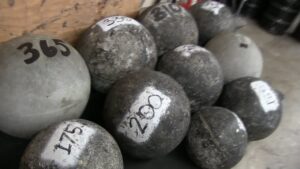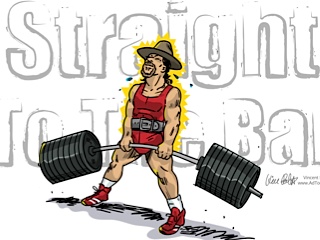Over the past couple of weeks there have been a number of strength feats involving replicas of the Inch Dumbbell. What was the original, and why is it held in such high regard?
Let’s take a look at the history of this incredible piece of equipment.
Origins of the Inch Dumbbell
 Thomas Inch (1881 – 1963) was a Strongman, Bodybuilder and Circus Performer in the early 20th century. In addition to his time with the iron, he wrote a number of superb books and articles; and is often credited with the introduction of plate-loading barbells and dumbbells to the general public.
Thomas Inch (1881 – 1963) was a Strongman, Bodybuilder and Circus Performer in the early 20th century. In addition to his time with the iron, he wrote a number of superb books and articles; and is often credited with the introduction of plate-loading barbells and dumbbells to the general public.
For one of his circus shows (around 1897), he had a local ironworks produce four dumbbells for him – weighing 75, 140, 153 and 172 lb. These bells were all manufactured – at Inch’s request – with handles somewhat thicker than normal; making them extremely difficult to lift. The lighter bells were given a 2″ handle, whilst the 172 (the one that’s usually replicated) had a handle almost 2.5″ (2.38″, to be precise) in diameter.
This exceptionally thick handle is a large part of the bells’ enduring appeal.
Strength Feats with the Inch (and replicas)
Inch’s performances with the famous dumbbell revolved around the fact that he was able to lift it, whilst other strong men could not. Although there were many people able to lift 172lb (a little under 80kg), the grip strength required to firmly hold the thick handle was beyond all but a few. Including, of course, Inch himself.
More recently, grip training has become an accepted discipline in its own right. The combination of grip work and more traditional forms of strength training have resulted in some truly impressive feats. A few of these are :
Steve ‘Mobster’ Gardener juggling a baby Inch.
The Diesel Crew enjoying a few rows with the 172.
‘Tex’ Henderson performs a 51′ Farmer’s Walk with two replica 172s.
Strongman Nick McKinless snatches a Baby Inch.
Learning how to train with an Inch Dumbbell replica
 If you’re like me, you enjoy doing things simply because they’re a challenge. To put yourself to the test here, there are two basic components :
If you’re like me, you enjoy doing things simply because they’re a challenge. To put yourself to the test here, there are two basic components :
Acquire an Inch Dumbbell replica : there are a few replica bells on the market, which reflect the shape, size, weight – and most importantly the handle – of the original bell. Additionally there are ‘Baby Inch’ bells, which offer the same size and appearance; with a slightly reduced weight (around 117lb).
However, tracking them down can take a bit of work. To date, eBay has been a good bet here; as well as suppliers such as Sorinex, IronMind and Atomic Athletic. All offer various solutions including the shot-loadable and plate-loaded versions.
Training with an Inch replica : Jedd wrote a series of superb articles (part I, II, III, IV and V) on training specifically with an Inch Dumbell replica. As you’ll quickly see, there’s more to this great piece of equipment than you might think. A great read.
Where is the Inch Dumbbell now?
 Of the four weights which were originally used (stated as 75, 140, 153 and 172lb), only the 172 is known to have survived (the others are missing, possibly thrown out after Inch’s death). The 172 itself was duplicated three times, and all 4 bells are now in the hands of private collectors. The photo at left shows one of them.
Of the four weights which were originally used (stated as 75, 140, 153 and 172lb), only the 172 is known to have survived (the others are missing, possibly thrown out after Inch’s death). The 172 itself was duplicated three times, and all 4 bells are now in the hands of private collectors. The photo at left shows one of them.
What’s next?
There are a number of strength feats which could be duplicated at some point in the future, using a replica Inch Dumbbell. My money’s on the dumbbell snatch – using a full-weight bell. What do you think?










0 Comments